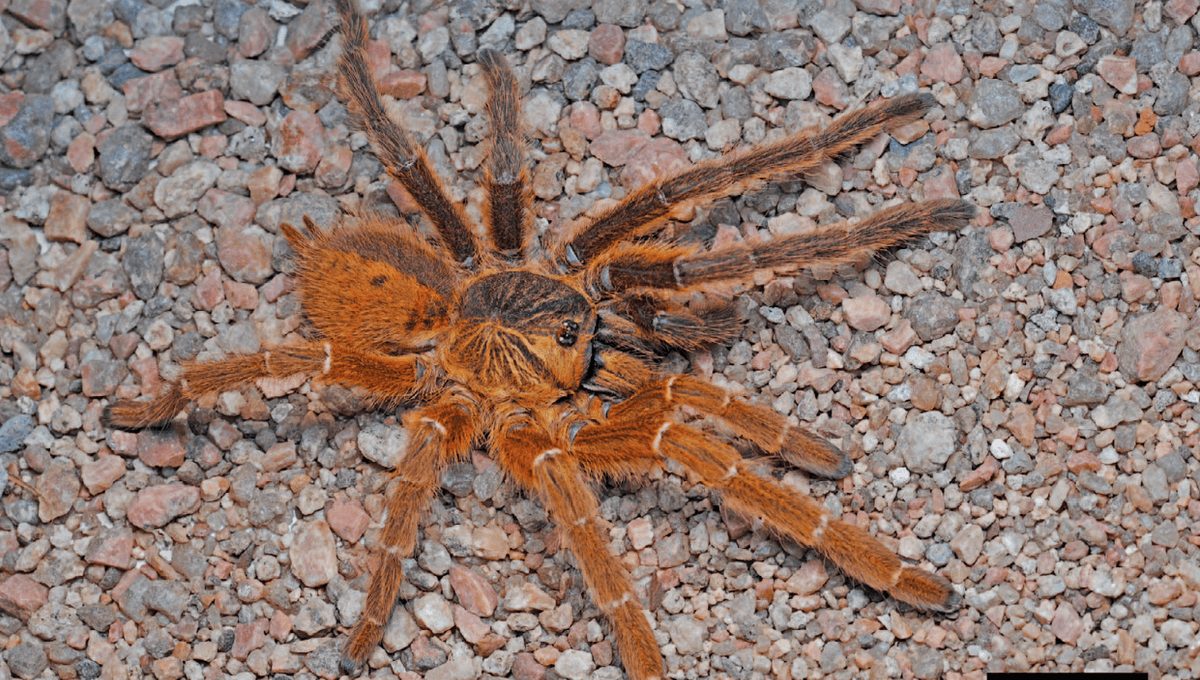
The stunning specimen you can see above was the first documented instance of a tarantula with gynandromorphic characteristics: one side of its body is female, while the other is male.
The case first came to light in 2014 at a lab at the University of the Republic in Uruguay when a team of bug experts was observing a bunch of orange baboon tarantulas (Pterinochilus murinus) that had just molted into adulthood.
After emerging from its former exoskeleton, one individual revealed a particularly interesting appearance. Perfectly split down the middle, the right side was hairier and had slightly chunkier limbs while its left side was barer and skinnier. A closer inspection revealed that the right side of the body was female, while the left side was male.
This is known as gynandromorphism, a genetic condition in which an organism is born with both male and female characteristics. It’s been reported in a variety of different animals, from stick insects and bees to an array of birds, but this was the first time it had been scientifically documented in a Mygalomorphae tarantula.
Initially, all seemed perfectly well with the unique tarantula and the researchers noted that the individual was seemingly unaffected by its condition.
“The gynandromorphic tarantula walked and fed normally. At least, we did not perceive any difficulty in its everyday behaviors,” Fernando Pérez-Miles, study author and entomologist at the University of the Republic, told IFLScience.
However, as it aged, some problems started to arise.
The gynandromorph underwent a molt after the maturation molt, and its male sexual organ suffered a deformation.
Fernando Pérez-Miles
“There are several peculiarities in the gynandromorph. In tarantulas, males do not continue to molt after their maturation, when their sexual organs, palpal bulbs, emerge. This is due to a morphological constriction, as the shape of the palpal bulb would make it difficult to molt those organs. However, females continue to molt after reaching maturity. The gynandromorph underwent a molt after the maturation molt, and its male sexual organ suffered a deformation,” explained Pérez-Miles.
The researchers also noted that the gynandromorph individual was vulnerable to aggression from others, although that’s perhaps not too surprising since the species is known for its feisty behavior.
“Another peculiarity was that we experimentally confronted the gynandromorph with females on four occasions; on none of these occasions did it court, nor did the females show any sexual response. In one encounter, the gynandromorph was attacked by a female, who injured one of its legs,” he added.
Despite these difficulties, the individual managed to live to a relatively normal age.
It’s not perfectly clear what causes gynandromorphism in any species, although it’s known to occur due to abnormal cell division and the segregation of the sexual chromosomes during early development.
In animals that use X and Y chromosomes to determine an individual’s biological sex (females typically with XX and males typically with XY), some gynandromorphic individuals will have some cells that may carry an X chromosome from one parent, while others may have a Y chromosome from the other parent. This results in mosaicism, in which cells within the same person have a different genetic makeup.
Spiders have significantly more complex sex chromosome systems, with varying compositions of sexual chromosomes across different species. This complexity had previously led scientists to assume that gynandromorphy was extremely rare in tarantulas. However, as always, nature is full of surprising exceptions to the rule.
The case study was first reported in The Journal of Arachnology in 2017.
Source Link: A Gloriously Rare Half-Male, Half-Female Tarantula Was Once Born In Uruguay